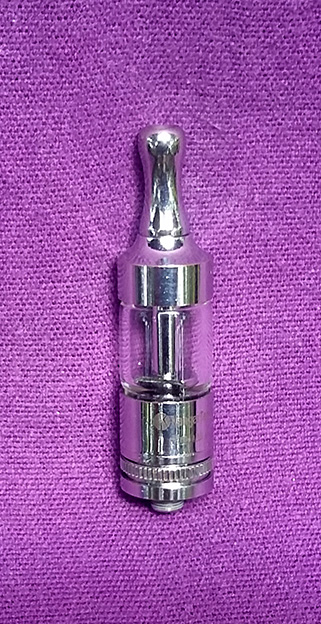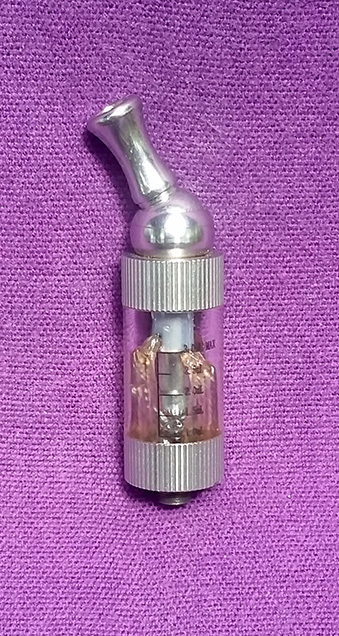
I’ve had my Innokin iTaste SVD for around three months now. I’ve used it extensively with both the Kanger Protank 3 and the Innokin iClear 30 clearomisers. I’ve notice a quirk or two so I’ve gathered my thoughts and composed this hopefully informative article on what has come to be known as my ‘Sonic Screwdriver’.
I’ll first give my impressions of the iTaste SVD battery and power unit whilst trying to contribute something to the instructions – the official user manual is a little terse, to say the least. I’ll then go on to compare the Protank 3 with the iClear 30 clearomisers, adding any interesting tidbits of detail I’ve discovered.
iTaste SVD by Innokin

I chose the Innokin SVD a few months ago as it seemed to be one of the best performing and most reliable SVDs in it’s class. Just as importantly, it also looked very cool. I did think the iTaste name was a bit of a cheesy play on the iMacStuff theme, but I didn’t let it put me off.
VV VW – eh?
My first impression was of frustration – the supplied user manual just does not go into enough detail, particularly regarding the variable voltage and variable wattage modes. Just as a guide to others, here’s how I *think* the whole VW/VV mode thing works:
VV is variable voltage
This is the more traditional way of adjusting the power you supply to the coil/s, thus controlling the amount and heat of the produced vapour. To set a pre-determined power level, you’ll need to know the coil’s resistance (this can be achieved using the built in ohm meter) to calculate the voltage you’ll need to set. The problem with VV is that certain conditions change whilst vaping – the coil heats up, thus lowering it’s resistance. The battery voltage will drop as it is discharged, thus lowering the overall power supplied to the coils. Because of these variations, you may find yourself constantly adjusting the voltage to get a consistent hit.
VV mode is selected by simultaneously holding the ‘fire’ and ‘-‘ buttons. The voltage is then set using the ‘+’ and ‘-‘ buttons. Note: the resistance of the coils can be measured by holding ‘+’ and ‘-‘ buttons simultaneously for two seconds.
VW is variable wattage Or more plainly, variable power.
Instead of having to make a calculation for each different clearomiser, the SVD does the calculation for you. I can only guess it does so by reading the coil’s resistance and doing the maths itself. Which is pretty cool, as you can then vape consistently, regardless of coil temperature, coil resistance or battery voltage without recalibrating anything. But most importantly, you don’t ever have to do any maths.
VW mode is selected by simultaneously holding the ‘fire’ and ‘+’ buttons. The wattage (power) is then set using the ‘+’ and ‘-‘ buttons.
Controlling the Power
The power range runs from 3 Watts to 15 Watts. I initially set wattages of around 7.5 for both clearomisers, but soon found that the flavours were better (for me at least) at a power of no more than 5 Watts. I occasionally use standard eGo cartomisers on the SVD, and for these I drop the power right down to the minimum (3 Watts). I’ve found that these low power settings have a number of advantages:
- battery lasts longer
- flavour is optimised
- coils burn out / start tasting bad far less often
On the subject of mixing and matching with eGo units, be careful if you connect an eGo battery with the Protank or iClear 30 clearomisers. Although they will screw together, I managed to wreck two eGo batteries as the harder material of the clearmisers stripped the thread on the soft metal batteries before I worked out what was happening.
The Downside
On the downside, the unit is not without it’s quirks. The most pronounced for me was the fact that the unit sometimes failed to fire. After a bit of investigation, I realised that the SVD won’t fire if the screen is displaying anything. Once I’d got into the habit of waiting for the screen to go blank before firing up, the problem disappeared.
I use the largest batteries possible for the SVD (18650 3400mah) and so use the longer battery cover option. I don’t really like the way the cover wobbles around when it’s screwed in place. The gap at the top of the battery cover is quite large, and I have heard some nasty grinding noises when unscrewing the cover after just a few grains of sand got inside.
I have seen forum posts with some users reporting the main fire button’s failing. As a result, I’ve been fairly gentle with mine and have had no hassle so far with the button.
Protank 3 by KangerTech

This clearomisor looked like the best bet at time of purchase – dual coils at the bottom of a pyrex tank with no ugly wicks showing through. A super shiny chrome-on-brass finish completed the lustre. One of the best things I can say about the Protank 3 is how it doesn’t leak – unless you fly with it (see my post about vaping and flyinghere for details of my experiences vaping at 32000 feet). But I can’t help but feel this design should have remained a pre-production model whilst the final kinks were ironed out…
Beefs
Possibly my biggest beef with the Protank 3 is the loose drip tip. This is the sole reason I don’t take my Protank out of the house – it would be just too easy for the drip tip to fall off and get lost. I’ve patched mine with some plumbing tape underneath the O-ring, but it still falls out too often to be trusted.
When I first assembled my Protank 3, the old style coils would not snap into place. It was only after a good deal of force was applied that it finally seated itself properly. These old style coils appear to have been in the process of being fazed out. The newer ones, aside from fitting properly, have a longer neck and so don’t have a tendency to leak, bubble or spit.
I found the draw very ‘airy’, but being new to vaping I didn’t know if this was expected. I used the clearomisor a fair amount, but it was rarely the number one choice.
Salvation
A month or two later I saw someone discussing the additional airflow device for the Protank. I purchased one and the transformation took place. The adjuster ring turns multiple times between off and on, but I found that mine gave the best results at 1/8 of a turn. Finally, the Protank had a draw that felt ‘right’.
Overall
When the Protank is working well, it works really well. All that theory about a pyrex tank being preferable to a plastic one and the use of no glue in the assembly seems to come to fruition. But it only happens after you have got the newer coils, bought an add-on airflow regulator and had a couple of draws already to warm the thing up.
Innokin iClear 30

When I bought the iTaste SVD it came with two iClear 30 clearomisers. My research had led me to believe that the Protank would suit my needs best. But, for reasons already mentioned, the Protank proved non-practical in many situations. As a result, I found myself using the iClear heads more and more often. The iClears are generally less hassle than the Protank, more reliable, with a more consistent behaviour. But the iClear 30 still feels less than 100% developed as a product.
On arrival, I loved the way the iClear worked straight out of the box, unlike the Protank which did not seem to want to be assembled. In terms of styling, I really liked the way the iClear matched the iTaste SVD and most of all, I loved the 360 degree swivel head. Another plus is the 3ml tank, larger than the 2.6ml for the Protank. Unlike the airflow control modified Protank, there is no fiddling about to get a good draw – the unit has the correct sized air holes which give the right amount of resistance for a decent inhale. Reliable, functional, consistent.
Annoyances
Probably the most annoying quirk of As discussed in my post about vaping and flying, both the iClear 30 and the Protank leak when changing from high to low pressure environments. Worse still for the iClear 30 (and unlike the Protank), the iClear unit has a tendency to leak out of drip tip if it’s left on it’s side or shaken about, especially when full.
Overall
The iClear has become my everyday vaporiser of choice, only really let down by it’s tendency to leak.
in summary
The iTaste SVD is a great piece of kit that feels like it should last many years. Of course, an SVD is basically just a battery case with variable power delivery – this is old technology and should be functional and reliable. The look and feel of the device are a bonus. After just a couple of months use, the chrome on the bottom of the device is starting to wear thin, revealing the brass beneath. I don’t see as a problem – to me it just lends the solid reliable feel a pleasing antiquated edge.
With regards the leaky nature of the iClear, the bottom line is: any product designed to hold liquid should do exactly that, if only just at ground level.
The less said about the release of the Protank 3 followed the by subsequent release of the parts to make it work properly (i.e. longer shaft replacement coils and airflow control device) the better. I guess Kanger have learnt a lesson here, as I notice the ProTank 3 is no longer listed on their website. Still I have the following message for Kanger: please, finish developing your products BEFORE launching them – pay no heed to those idiots in marketing and management, they don’t have their priorities straight, they never do! Always trust and listen to the engineers, as for me, there is evidence of excellent but incomplete engineering present in all three devices reviewed here.
post note
Well, that’s all I have to say on the hardware side for now. I’ve just finished my first month of ejuice mixing experiments. Such fun new hobby! More on that in my next post…
I couldn’t resist commenting. Very well written!